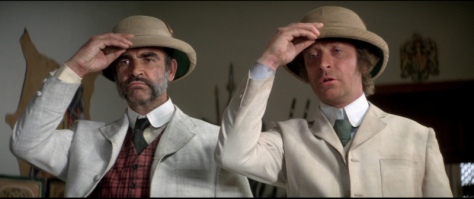By Dennis Hartley
(Originally posted on Digby’s Hullabaloo on December 29, 2012)

With hindsight being 20/20 (as my gaffer used to say) it seems that Peter Jackson has been running the chalk backwards. The Hobbit or There and Back Again (published in 1937), J.R.R. Tolkien’s first foray into his wondrously immersive world of “Middle Earth”, is a straightforward fantasy-adventure novel. At 300 or so pages, it’s just right for a stand-alone film adaptation.
Adapting Tolkien’s subsequent Lord of the Rings trilogy for the screen, on the other hand, is a more challenging undertaking. The three volume tome is not only a darker, more intricate affair, full of vividly imagined scenarios and rich characterizations, but rife with meticulously annotated genealogies and scholarly referenced “histories”. Hence, it is a logical candidate for a 3-film adaptation.
As anyone not living in a cave with Gollum over the past decade knows, Jackson went for the (massively successful) trilogy first, starting with The Fellowship of the Ring in 2001. Now if Jackson was truly going sequentially, he should have begun with The Hobbit. Given the movie making technology available when principal filming on LOTR began (1999), he could have produced a serviceable, stand-alone 3-hour film .
I suppose this is my long-winded way of addressing Jackson’s controversial (well, among the geeks who care about this sort of thing) creative choice to s-t-r-e-t-c-h his film adaptation of The Hobbit into three films, to be released over just as many years.
I imagine that cynics will be quick to point out the obvious financial benefits Jackson stands to reap by milking the franchise, but considering LOTR’s combined earnings to date of nearly 3 billion dollars…I don’t think he’s necessarily doing it “for the money”.
No, I have a different theory, which gets back to my original point about movie making technology. I’m no psychologist, but I believe that Mr. Jackson is suffering from GLTS (George Lucas Tweaking Syndrome).
I think he’s looking at the exponential leaps and bounds in motion-capture, CGI and 3-D technology that have occurred since he wrapped the trilogy, and he’s thinking to himself, “Damn, I could have used those latest bells and whistles on LOTR…well, I can’t go back in time, but I’ll still show James Cameron and the rest of them a frickin’ hi-res, 3-D trilogy full of orcses and hobbitses, my prreciouss!”
Lest you begin to wonder if I’ve decided to turn my review of The Hobbit: An Unexpected Journey into a three-part post, spread out over just as many Saturday nights, this seems just as good a time as any to actually begin the review (for those of you patient souls who haven’t clicked out of this 500 word-and-counting snore fest yet).
You see, in a hole in the ground there lived a Hobbit…OK you already know that part. So, you remember old Bilbo Baggins (Ian Holm) from the LOTR films? While he does have a cameo here, this story centers on the young Bilbo (Martin Freeman), and his first major “adventure” beyond the boundaries of his beloved Shire.
Just as awaits his nephew Frodo in the future, the agoraphobic Bilbo is ripped from his comfort zone by one Gandalf the Wizard (a returning Ian McKellen, not looking a day over 637). Soon after a cryptic heads up from Gandalf about some out-of-town pals who might drop by the crib , Bilbo finds no less than 13 ravenous dwarves descending on his formidably-stocked pantry like locusts.
And no sooner can you say “we’re off on a quest”, Bilbo has been sweet-talked into signing on as a “burglar” to help alpha dwarf Thorin Oakenshield (Richard Armitage) and his dirty dozen reclaim the house of his faddah from the evil dragon squatter, Smaug.
While the director and his co-writers Fran Walsh, Philippa Boyens and Guillermo del Toro have been careful to preserve most of the characters and creatures featured in Tolkien’s original story (including orcs, wargs, trolls and a goblin king who looks like Jabba the Hut’s first cousin with a tremendous goiter issue) they’ve also tossed a few new ones into the mix (how else are they going to embroider what I assume is destined to become the number one 11-hour bong, pizza and Blu-ray marathon of choice in 2015?).
I’m not sure yet how I feel about the Pale Orc, a heavy who seems destined to play the One Armed Man to Bilbo’s Dr. Richard Kimbel, gloming on to him and his dwarf buds like a bad suit all the way to the goddam Lonely Mountain (admittedly it’s been quite a while since I read the book, but I’m fairly sure he’s new). At any rate, until such time as someone heroically cleaves him in twain in a sequel, I guess I’ll live with it.
The real scene-stealer in this outing is Andy Serkis, returning as the younger version of the creature Gollum, who has his fateful first encounter with one of those “filthy Bagginses”.
There have been grumblings in some corners about the film being a little “cutesy” compared to its predecessors; aside from a goofy housecleaning scene where I half-expected the merry dwarves to break into a rendition of “Whistle While You Work” I didn’t see it.
What I did see was a story with a surprising amount of heart, especially when one considers how easily the undeniably dazzling technical wizardry involved in bringing Tolkien’s universe to life could overshadow the flesh and bone performances.
That being said, there are some real knockout set pieces, especially if you opt for seeing the film in the high-res 3-D presentation. The best eye-candy sequence involves Rivendell, which here looks like the kind of place I could really settle down with Cate Blanchett and raise a couple of half-elven kids (I can always dream, can’t I?).










